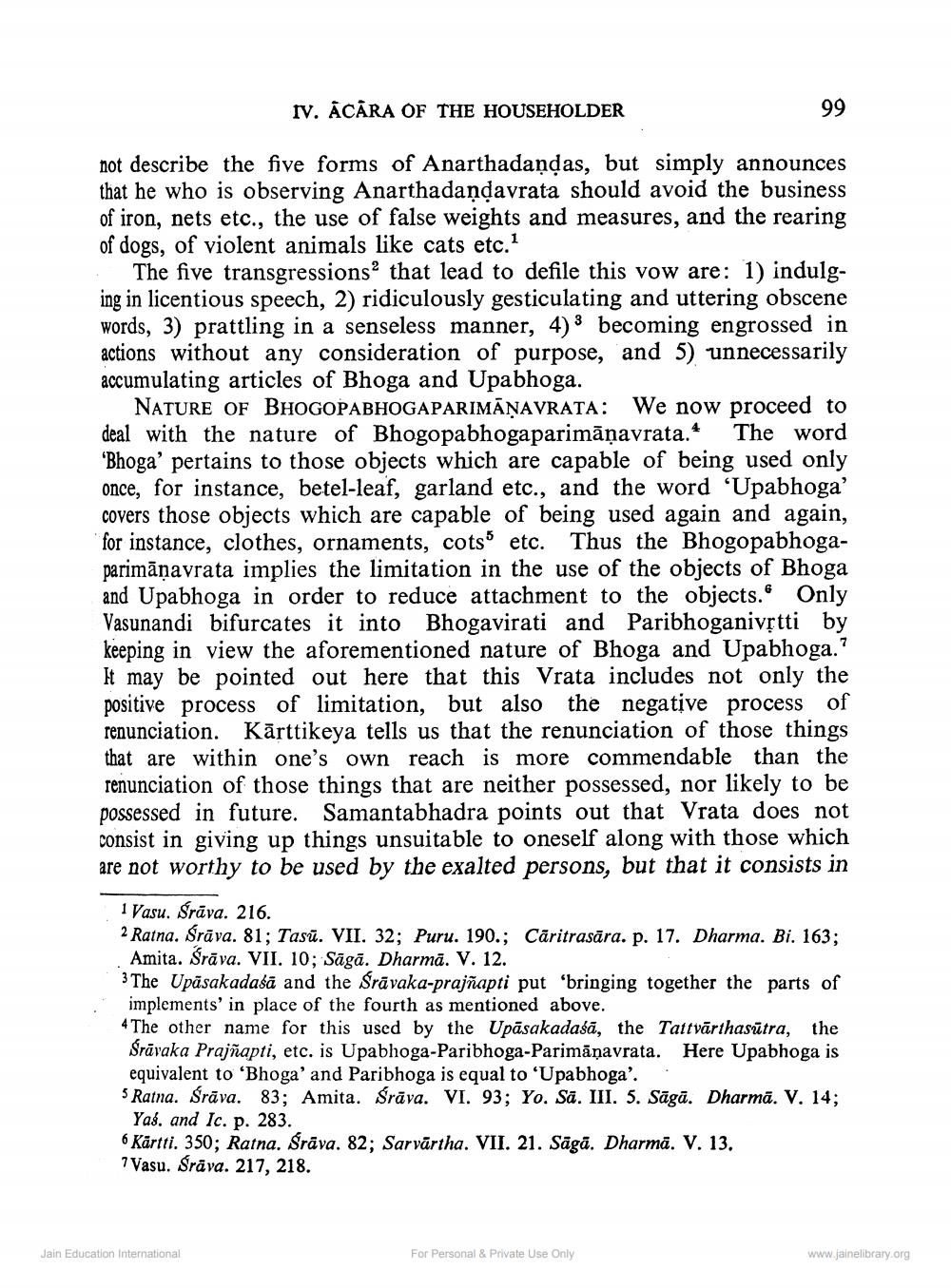________________
IV. ACARA OF THE HOUSEHOLDER
99
not describe the five forms of Anarthadaņdas, but simply announces that he who is observing Anarthadandavrata should avoid the business of iron, nets etc., the use of false weights and measures, and the rearing of dogs, of violent animals like cats etc.
The five transgressions that lead to defile this vow are: 1) indulging in licentious speech, 2) ridiculously gesticulating and uttering obscene words, 3) prattling in a senseless manner, 4) : becoming engrossed in actions without any consideration of purpose, and 5) unnecessarily accumulating articles of Bhoga and Upabhoga.
NATURE OF BHOGOPABHOGAPARIMĀŅAVRATA: We now proceed to deal with the nature of Bhogopabhogaparimāņavrata. The word ‘Bhoga' pertains to those objects which are capable of being used only once, for instance, betel-leaf, garland etc., and the word 'Upabhoga' covers those objects which are capable of being used again and again, for instance, clothes, ornaments, cots etc. Thus the Bhogopabhogaparimāņavrata implies the limitation in the use of the objects of Bhoga and Upabhoga in order to reduce attachment to the objects. Only Vasunandi bifurcates it into Bhogavirati and Paribhoganivștti by keeping in view the aforementioned nature of Bhoga and Upabhoga." It may be pointed out here that this Vrata includes not only the positive process of limitation, but also the negative process of renunciation. Kārttikeya tells us that the renunciation of those things that are within one's own reach is more commendable than the renunciation of those things that are neither possessed, nor likely to be possessed in future. Samantabhadra points out that Vrata does not consist in giving up things unsuitable to oneself along with those which are not worthy to be used by the exalted persons, but that it consists in
1 Vasu. Srāva. 216. 2 Ratna. Srāva. 81; Tasū. VII. 32; Puru. 190.; Căritrasāra. p. 17. Dharma. Bi. 163;
Amita. Śrāva. VII. 10; Sāgā. Dharmā. V. 12. 3 The Upāsakadašā and the Srāvaka-prajñapti put 'bringing together the parts of implements' in place of the fourth as mentioned above. 4 The other name for this used by the Upāsakadaśā, the Tattvārthasūtra, the Srāvaka Prajñapti, etc. is Upabhoga-Paribhoga-Parimāņavrata. Here Upabhoga is equivalent to 'Bhoga' and Paribhoga is equal to 'Upabhoga'. . 5 Ratna. Śrāva. 83; Amita. Śrāva. VI. 93; Yo. Sā. III. 5. Sāgā. Dharmā. V. 14;
Yaš. and Ic. p. 283. 6 Kärtti. 350; Ratna. Srava. 82; Sarvārtha. VII. 21. Sāgā. Dharmā. V. 13. 7 Vasu. Srāva. 217, 218.
Jain Education International
For Personal & Private Use Only
www.jainelibrary.org




